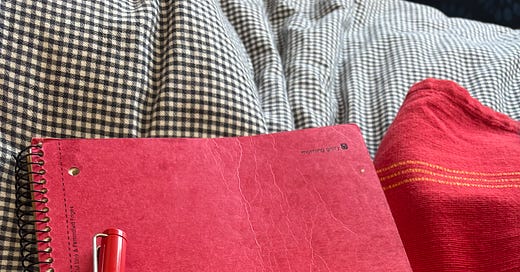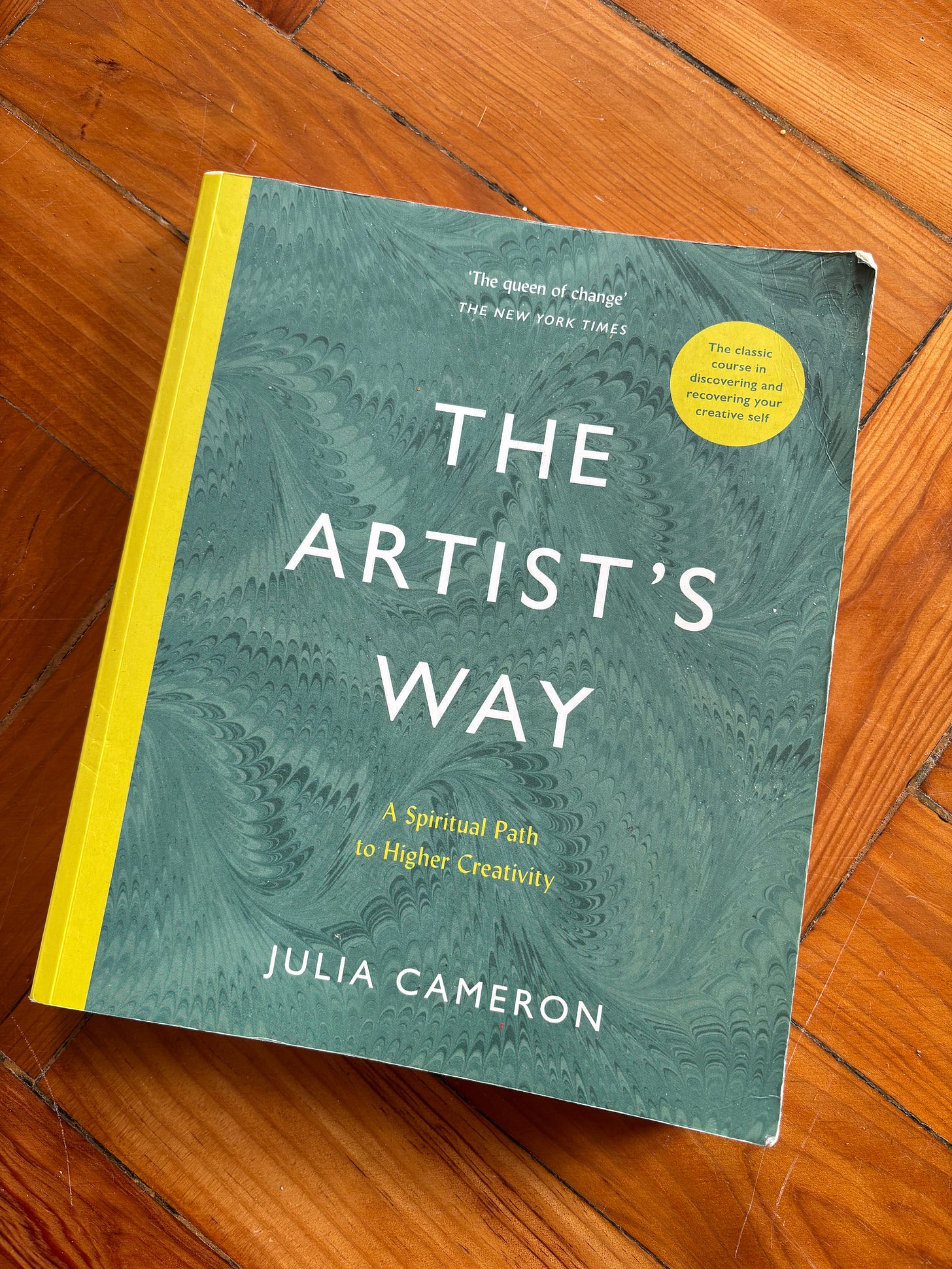How Writing Continues to Save My Life
Morning Pages, Letters From Love, Pennebaker Method, Worry Scripts and Other Forms of Therapeutic Writing
When I was a teenager, I kept a diary on and off. I used it to write about things that worried me—secret thoughts, obsessions, and the mental loops I couldn’t seem to get out of. For a while, I even had a diary with a lock. It seemed to me like something serious diarists would do.
In the early 1990s, I developed an obsession with a particular type of Korean notebook (anyone else a fan of Morning Glory?), sold only in a stationery shop in Zagreb, Croatia—possibly also in Korea, of course—but crucially, not in Ljubljana, where I lived until I was 25.
The diary served as a kind of confessional. It was a space that could hold what I didn’t dare share with anyone else, things I felt were embarrassing or even shameful. I’ve kept a couple of those journals, but over the years, I’ve gotten quite good at purging material belongings. Most of my pre-25 diaries are long gone, so I can’t really tell you much about the content, beyond the sense that it was probably rather inconsequential.
Since around 2012, I’ve been experimenting, on and off, with other types of personal writing. I don’t remember exactly when I first encountered the idea of morning pages, but it was sometime after 2010. Julia Cameron introduced the concept in The Artist’s Way, though I first came across it in one of her follow-up books, The Sound of Paper. Cameron’s practice involves writing three handwritten pages of unfiltered, stream-of-consciousness thoughts every morning, ideally first thing after waking up. Alongside this, she encourages weekly “artist dates” and a series of themed exercises to help clear inner blocks to creativity.
When I first started writing morning pages, I was living alone with three dogs on a hill in Addis Ababa, Ethiopia. Besides being busy with work, I led a very simple, possibly boring, life. Except when I was on the road, my routine was steady. Frequent power cuts and government-imposed internet shutdowns meant I often had time in the mornings to write (and I didn’t get a smartphone until late 2013. Even then, the data coverage was poor and I had no internet at the house most of the time). In the absence of good English-language talk therapy, morning pages became a way to process things.
I left Ethiopia in a rush in March 2020 because of Covid-19. When I moved to Sweden later that summer, I stopped writing the pages, for a number of reasons, which in hindsight may have been just excuses. In January 2022, I returned to Addis to pack up my belongings. I came across a box of old morning pages notebooks and was amazed by the sheer volume of writing I’d produced over the years. I skimmed through some pages and felt relief. Many of the things that had once worried me now seemed resolved, or even banal. The pages had served their purpose, and life had moved on. I was ready to let them go. So I tore them up and threw them in the trash.
In December last year, after I moved out of the apartment I had shared with my ex and into a new place, to begin life as a single woman again, I passed my favourite bookstore in Lisbon. A copy of The Artist’s Way was in the window display. I decided it would be my Christmas present to myself. The creative plan the book offers felt like the right way to mark this new chapter.
But to really start, I needed an external push. It came from
, a fellow Substack writer and author of the beautiful publication Life after Trauma. She invited Substackers to join her in working through The Artist’s Way.Clare created a space where writers could go through the 12-week program together. Each week, she shares a companion article and opens a space for group reflection. She also hosts a monthly call where participants discuss how the practice is impacting their lives.
Conversations with Clare and the other women in the group helped me realise that we all struggle with aspects of the practice. We also find deep value in it. Being held by Clare, and by the others, makes me feel less alone.
One of my major realisations has been around how I tend to turn morning pages into a kind of doctrine—something I also do with other habits. If I couldn’t manage three pages first thing in the morning, I felt I had failed.
But now there are days when I only manage one page. Sometimes I write in the afternoon. And I’ve discovered that the world doesn’t fall apart. I’m learning that setting smaller, more flexible goals helps me relax, and return to the page with more ease
.
Morning pages aren’t the only form of therapeutic writing I've explored. There are many ways to use writing as a healing tool.
For instance, I took part in a four-week program Writing for Better Health created by
, author of the What Now? publication here on Substack. I first joined in October/November last year, and I found it deeply healing. Lindsay’s approach is inspired by the Pennebaker method of expressive writing, which encourages structured reflection on emotional experiences—but she adapts it thoughtfully, with particular care for women writers.The Pennebaker Method is a therapeutic technique developed by Dr. James Pennebaker to improve mental and physical health through writing about emotional experiences. It involves writing about stressful, traumatic, or emotional events for 15-20 minutes over 3-5 consecutive days.
The idea is that putting thoughts and feelings into words helps us process them, reduce stress, and improve overall well-being. Like morning pages, there’s no need to worry about grammar or syntax, the point is to get the words out as a form of release.
In Lindsay’s workshop, each session gradually builds toward a longer 15-minute writing session, beginning with 3-5 minute warm-ups. After we’re done, we’re encouraged to discard, burn, or tear up the writing. The idea isn’t to hold on to the pain, but to let it go through the act of writing.
Another therapeutic approach I’ve used is worry scripts. Like the Pennebaker method, they use writing to process emotion, but the focus is different. While Pennebaker’s method encourages free expression around significant events, worry scripts are more structured. They help you face specific fears and imagine outcomes in a controlled, problem-solving way.
I used worry scripts under the supervision of a CBT therapist a few years ago. They helped me contain my tendency to obsess over things outside my control, keeping my worries limited to a specific time and place. Writing them out often made me realise how unfounded many of my fears were. Of course, some worries did come true. A recent discovery of a worry script notebook from three years ago even revealed a bit of clairvoyance on my part. But that’s a story for another place and time.
If Pennebaker and worry scripts help us grow more comfortable with discomfort, another writing tool I’ve found powerful is Elizabeth Gilbert’s Substack series Letters from Love. Her exercises are gentler and more nurturing, but just as powerful. They’re a powerful counter to the inner critic and the harsh voice of self-judgment. One of her recent letters, which you can find here, about how things get better after a breakup, helped me immensely.
As a coach, I often see how easily people, especially women, fall into self-criticism. We are great at naming everything we think we are doing wrong. But we often struggle to pause and offer ourselves kindness. When I sense that a client is stuck in that loop, I may invite them to write a letter “from Love” to themselves. The results are always moving. There’s something powerful about remembering that we are loveable.
I’ve tried writing these letters myself. It’s not easy. I feel huge resistance, especially from my inner critic. But when I push through and write them, I’m always surprised by how meaningful and encouraging they are. And re-reading them, because unlike with the Pennebaker method, the idea is not to throw them away,can be a powerful reminder of self-love, especially when the inner critic is loud and it feels nearly impossible to connect with the wise, loving part of myself.
There’s one final writing practice I’ve found really helpful. In 2018, I attended a week-long group therapy retreat called the Hoffman Process. There, we were introduced to a practice called Appreciation and Gratitude. I’ve kept it, on and off, ever since. It’s simple: each day, write down two things you’re grateful for (a warm shower, a text from a friend), and two things you appreciate about yourself (a quality, a gesture, or even just the fact that you’re writing your Appreciation & Gratitude journal).
When I was packing up my Addis belongings in 2020, I found two years’ worth of these entries. Leafing through them reminded me of so many beautiful moments. I also saw that on some days, all I could write was that I’d had three meals. And that was enough. Research shows that this activity stimulates the release of dopamine and serotonin, which help us feel happier and more content.
And really,
who wouldn’t want to feel a little more of that?
So, before I sign off, I want to share with you my appreciation and gratitude notes for today:
I am grateful that I had a full fridge this morning so I could have a good breakfast.
I am grateful for a friend who messaged me about avoiding football hooligan hotspots in Lisbon today, after a big match between the two rival teams.
I appreciate that I finally sat down and wrote this post.
I appreciate that I took time to respond to text messages from a friend.






Really liked this post. Thank you for sharing your writing practices and how each one helps you feeling better throughout your days. I think I might try Morning Pages too. It sounds like something that would help my writing practice and also me personally.
Like you Liza I've experimented on and off with morning pages but it's never really taken root - 3 pages every day seems like a huge commitment! But I may revisit again with your good advice that it might be just 1 page or written in the evening instead. Also so glad I learned about the Pennebaker Method via Lindsay! Writing about painful things for 5-10 minutes and then ripping the words up is good medicine.